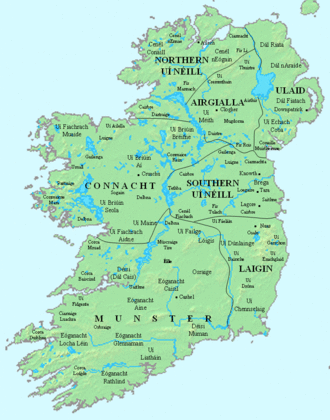This article includes a list of general references, but it lacks sufficient corresponding inline citations. (June 2020) |
Maigh Seóla (Irish pronunciation: [mˠəi ˈʃoːl̪ˠə]), also known as Hy Briuin Seola, was the territory that included land along the east shore of Lough Corrib in County Galway, Ireland. It was bounded to the east by the Uí Maine vassal kingdom of Soghain and extended roughly from what is now Clarinbridge in the south to Knockmaa Hill in the north. Its rulers belonged to the Uí Briúin Seóla and are sometimes found in the annals under the title "King of Uí Briúin" and "King of South Connacht". The earliest identifiable kings belonged to the line that became the Clann Cosgraigh. However in later times the line which would become the Muintir Murchada, under the O'Flaherty chiefs, monopolized the kingship.

The Muintir Murchada were based at Loch Cime (later called Lough Hackett) until forced west of Lough Corrib during the de Burgo led English invasion of Connacht in the 13th century. According to the 17th-century historian Ruaidhrí Ó Flaithbheartaigh, Maigh Seóla was considered part of Iar Connacht prior to the 13th-century Anglo-Norman invasion of Connacht. After the de Burgo / Burke family became established in Maigh Seola the territorial term Iar Connacht was only used to denote the territory of the O'Flahertys west of Lough Corrib and Lough Mask.
In English, the plain of Maigh Seóla is also known as Moyola.[1]
Kings of Maigh Seóla
edit- Donn mac Cumasgach, died 752
- Connmhach Mór mac Coscraigh, died 846
- Maelan mac Cathmogha, died 848
- Murchadh mac Maenach, died 891
- Cléirchén mac Murchadh, died 908
- Urchadh mac Murchadh, died 943
- Donnchadh mac Urchadh, died 959
- Murchad mac Flann mac Glethneachan, died 973
- Ruaidhrí mac Coscraigh, died 992
- Maelcairearda, died 993
- Brian mac Maelruanaidh, died 1003
- Muireadhach ua Flaithbheartach, died 1034
- Murchadh an Chapail Ua Flaithbheartaigh, died 1036
- Cathal mac Ruaidhri, died 1043
- Amhalgaidh mac Cathal, died 1075
Annalistic references
editFrom the Annals of the Four Masters:
- M990.7 - The wind sunk the island of Loch Cimbe suddenly, with its dreach and rampart, i.e. thirty feet.
See also
editReferences
edit- ^ Duffy, Seán (2005). Mediaeval Ireland: An Encyclopaedia. New York, London: Routledge. p. 485. ISBN 0-415-94052-4.
- A Chorographical Description of West or H-Iar Connaught written A.D. 1684 by Roderic O'Flaherty ESQ with notes and Illustrations by, James Hardiman M.R.I.A., Irish Archaeological Society, 1846.
- Medieval Ireland: Territorial, Political and Economic Divisions, Paul MacCotter, Four Courts Press, 2008, pp. 133–134. ISBN 978-1-84682-098-4